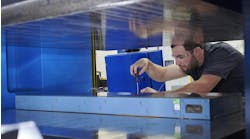Last Friday, when I attended The Fluid Power Challenge sponsored by Daman Products Co. Inc. at the University of Notre Dame, I had an opportunity for a quick tour of the new engineering building at the university.
The building was built in 2009 and includes many modern amenities that were unheard of in my college days — changeable spaces, with access to furniture, white boards, computers, wi-fi, etc. that allow for quiet study or collaborative work. When Jay Brockman, associate dean, started the tour, he mentioned how the engineering department tries to tie the university's mission in with studies — that is, to be engineers for the greater good. Notre Dame students are not just engineering students learning a career, they are there to make a difference in the world around them.
One of the most impressive features of engineering department was its clean room facilities, with a focus on nanotechnology studies. The room is divided by particle size and allows students to focus on material and bioelectrical studies.
Things were pretty quiet as students were gearing up for finals but I did get to see the CAD/CAM lab in action, where undergraduate students learn how to use the software to design a maze, and then use the cutting tools to make the final product. Designs ranged from the traditional to unique, with round or square mazes to ones shaped like the famous ND logo and even a caterpillar.
As a Catholic, I was struck, too, by the beauty of a small chapel they included in the building. Students can go there to take a break and have some quiet time, or enjoy Mass when its offered. I was starting to see what all the hype is when it comes to that university. Now I look forward to what these future engineers can do for the greater good of humanity. Go Irish!
